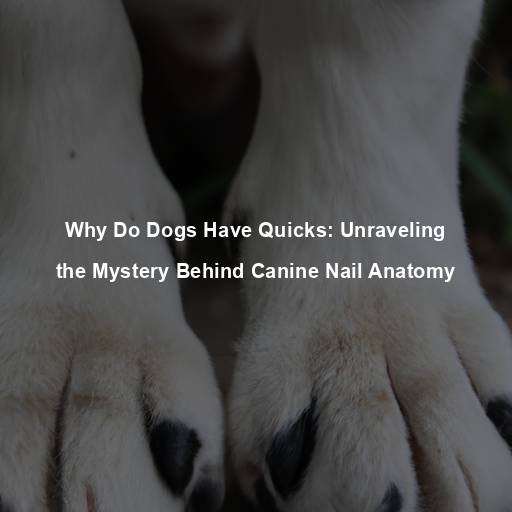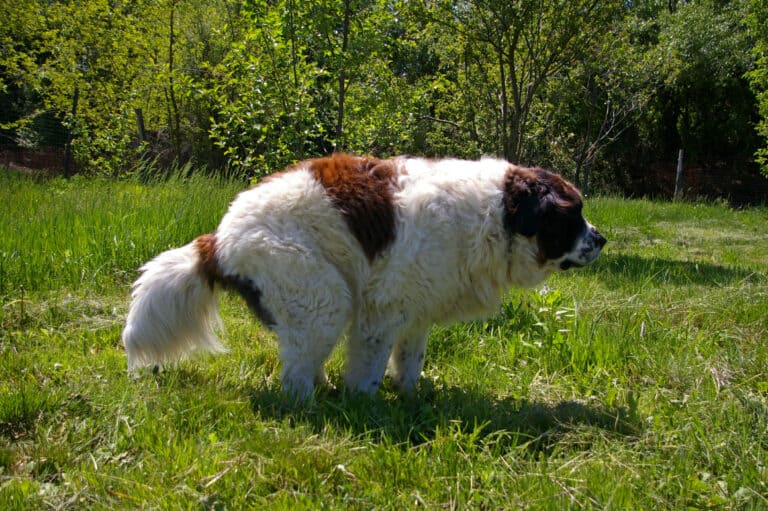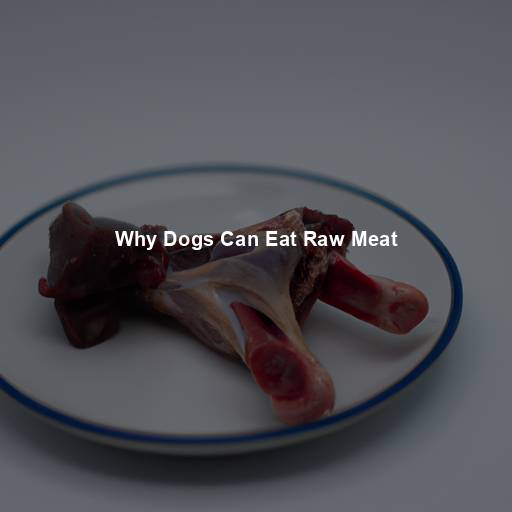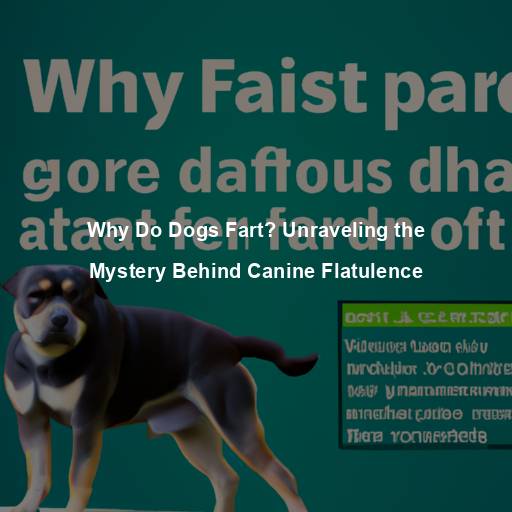Why Do Dogs Have Quicks: Unraveling the Mystery Behind Canine Nail Anatomy
Last Updated on November 4, 2023 by Evan
Contents
- 1 Unveiling the Mysteries of Canine Nail Anatomy
- 2 A World of Canine Discovery Awaits
- 3 FAQs: Why do dogs have quicks?
- 3.1 What are quicks in relation to dogs?
- 3.2 Why do dogs have quicks in their nails?
- 3.3 Can nail trimming harm a dog’s quick?
- 3.4 Do different dogs have different quick lengths?
- 3.5 Is it possible to shorten a dog’s quick over time?
- 3.6 What should I do if I accidentally cut my dog’s quick?
- 3.7 Can dogs still walk and function normally if their quick is injured?
- 3.8 How often should I trim my dog’s nails to maintain a healthy quick?
Unveiling the Mysteries of Canine Nail Anatomy
Ever pondered the enigmatic presence of quicks in our canine companions’ paws? This peculiar quagmire has left pet parents and dog aficionados bewildered. As we venture into the uncharted territory of canine nail anatomy, an expedition brimming with perplexity awaits us. Our quest to decipher the secrets behind the quicks will illuminate their evolutionary significance and shed light on the practical purposes they serve in the intricate world of our precious furry pals.
The Evolutionary Origins of Canine Nails
To understand why dogs have quicks, we must first trace their evolutionary origins. Dogs, descendants of wolves, have inherited many of their ancestors’ traits, including their nail structure. Wolves, being wild animals, rely on their nails for various purposes, such as hunting, self-defense, and territory marking. As dogs evolved from their wolf ancestors to become domesticated companions, their nail anatomy adapted to suit their changing needs.
The Purpose of Canine Nails
Canine nails serve multiple purposes, each playing a vital role in a dog’s life. Let’s explore some of these functions:
- Traction: One of the primary purposes of a dog’s nails is to provide traction. Dogs are known for their agility and swiftness, and their nails play a crucial role in maintaining stability while running, jumping, and turning. The grip provided by their nails enables them to navigate various terrains with ease.
Have you ever watched a dog engage in the age-old practice of digging and burrowing? It’s truly fascinating how their instincts kick in, propelling them to excavate the earth with ease. With their sharp and durable nails, dogs effortlessly search for buried treasures or create cozy dens where they can find solace. It’s no wonder these four-legged creatures embody the essence of curiosity and resourcefulness in their never-ending quest to satisfy their deepest primal desires.
When it comes to self-defense, dogs have a natural instinct to protect themselves, much like their wolf ancestors. One remarkable feature that comes into play is their extendable nails, which can unexpectedly transform into formidable weapons. In moments of peril or confrontation, dogs can rely on their sharp nails to fend off potential threats and secure their safety if the situation calls for it.
Grooming your beloved canine companion involves more than just a simple bath and a brush. You may have noticed that your furry friend frequently relies on their paws and teeth to maintain their pristine appearance. From scratching away pesky dirt and debris to removing those pesky loose hairs, dogs have a natural instinct for self-care. Beyond aesthetics, this grooming routine also stimulates blood circulation, which paves the way for healthier skin and a lustrous coat.
Understanding the Quicks in Canine Nails
Intriguing and captivating, let’s delve into the enigmatic realm of quicks – those mysterious, vascular and nerve-rich zones hidden within our beloved canine companion’s nails. With their role in nurturing nail growth and vitality, these intricate networks of blood vessels and nerve endings possess a remarkable sensitivity that leaves us pondering their nature. As we unravel the enigma surrounding quicks, we uncover a captivating world of canine physiology, where nourishment and sensitivity intertwine in a dazzling display of complexity.
- Blood Supply: The quicks in a dog’s nails are the primary source of blood supply to the nails. They deliver essential nutrients and oxygen, facilitating the growth and maintenance of healthy nails. The blood vessels within the quicks play a vital role in this process, ensuring that the nails remain strong and resilient.
Have you ever wondered why your furry friend seems to wince and pull away when you try to trim their nails? Well, the answer lies in the incredible sensitivity of their quicks. These tiny nerve endings, abundantly present in a dog’s nails, act as a built-in defense mechanism. Any sharp object or a close trim can send an alarming signal to their delicate quicks, causing discomfort and even leading to bleeding.
Trimming Dog Nails: A Delicate Balance
As responsible pet owners, it is crucial to maintain our dogs’ nails and keep them at an appropriate length. However, trimming a dog’s nails requires a delicate balance to avoid cutting into the quicks and causing pain. Let’s explore some essential tips for trimming dog nails safely:
Prepare Yourself: Take a moment to acquaint yourself with the intricate structure of your furry friend’s nails. It’s crucial to understand the nuances of their anatomy and locate the ever-elusive quicks, as they can differ in size between breeds and individuals. By attaining this knowledge, you’ll gain the confidence to confidently assess the ideal amount of nail to trim, ensuring your dog’s safety and comfort.
-
Gather the Right Tools: To successfully trim your dog’s nails, you’ll need a few essential tools. Invest in a high-quality pair of nail clippers specifically designed for dogs, as they offer better precision and control. Additionally, have styptic powder or cornstarch on hand to halt any bleeding that may occur if you accidentally trim too much.
-
Find a Comfortable Setting: Choose a calm and quiet space where you and your dog can feel relaxed. It’s crucial to find a setting where you can minimize distractions and create a peaceful atmosphere. By doing so, you’ll ensure that your furry companion is at ease, making the nail trimming experience much more manageable and stress-free for everyone involved.
-
Take It Slow and Steady: Remember, Rome wasn’t built in a day, and neither should your dog’s nail trimming skills. Take your time and approach the process with patience and understanding. Start by gently touching your pup’s paws and introducing the clippers gradually.
-
Use the Right Tools: Invest in high-quality nail clippers or grinders specifically designed for dogs. These tools are designed to provide better control and minimize the risk of accidentally cutting into the quicks. Additionally, keeping the tools clean and sharp will ensure a smoother and safer trimming process.
Taking care of your furry companion’s nails can be quite the challenge, especially if they are not used to it. However, a gradual approach can make all the difference. Start by carefully trimming a small section of the nail, paying close attention to the curved part before the quicks. By gradually introducing your dog to this routine, they will eventually grow more at ease with the process, resulting in a safer and more successful nail trimming session.
Navigating the realm of dog nail trimming can be overwhelming and fraught with uncertainty. If you find yourself questioning your abilities or feeling uneasy about the task at hand, it may be wise to consider seeking the invaluable assistance of a professional groomer or veterinarian. These seasoned experts possess the necessary knowledge and skillset to deftly trim your beloved pup’s nails, ensuring a safe and efficient process that minimizes any potential harm.
Nail Health and Maintenance
Maintaining your dog’s nail health goes beyond regular trimming. Here are some additional tips to keep their nails in optimal condition:
Keeping a close eye on your furry friend’s paw maintenance is essential for their overall well-being. Make it a habit to frequently inspect your canine companion’s nails, looking out for anything that seems amiss – such as swelling, redness, or any unusual discharge. Should you come across any irregularities, it is wise to seek advice from your trusted veterinarian to ensure that your beloved pet receives proper care and guidance.
Discover the secret to naturally maintaining your dog’s fabulous nails. By incorporating regular exercise and exciting outdoor adventures into their routine, you can effortlessly combat overgrown nails. Exploring various terrains like pavement or rugged landscapes not only promotes healthy nail length, but also ensures their paws are in tip-top shape. Remember, though, balance is key, as excessive wear can potentially result in discomfort or accidents.
A glowing and robust set of nails for your beloved furry friend is not just a whimsical desire, but an essential part of their overall well-being. Nourishing their paws from within requires a careful embrace of a quality diet, bursting with vital nutrients like biotin, zinc, and omega-3 fatty acids. These powerful elements will weave their magic and cultivate healthy nail growth and strength for your canine companion. Seek guidance from your trusted veterinarian to curate a bespoke dietary plan, tailored to suit your dog’s unique needs and perplex the ordinary.
- Positive Reinforcement: Make nail maintenance a positive experience for your dog. Offer treats, praise, and rewards during and after nail trimming sessions to associate the process with positive outcomes. This will help reduce anxiety and make future nail care more manageable.
The Bond Between Humans and Dogs
As we conclude our exploration of why dogs have quicks, it is essential to reflect on the profound bond between humans and dogs. Dogs have been our loyal companions for thousands of years, offering unwavering love, companionship, and protection. Understanding their anatomy, needs, and instincts allows us to cultivate a deeper connection and provide them with the care they deserve.
When you’re faced with the task of inspecting your canine companion’s tiny talons or braving the nail trim journey, take a moment to reflect on the intricacy and intention behind those itty bitty quicks. Embrace the chance to tend to your beloved fur baby’s nail care needs, for it symbolizes the extraordinary connection you both uniquely possess.
A World of Canine Discovery Awaits
Prepare to embark on a dazzling expedition into the enchanting realm of dogs, where every twist and turn reveals a captivating surprise. Delve into the extraordinary world of these magnificent creatures, adorned with an array of bewildering marvels waiting to be unearthed. Brace yourself for heartwarming sagas that will melt even the stoniest of hearts, accompanied by sage advice from the foremost authorities that will elevate the existence of our cherished four-legged friends. Do not miss this opportunity to immerse yourself in the remarkable and perplexing universe of canines that will leave you breathless and yearning for more.
Welcome to PetsRoof.com, where our mission is to explore the enchanting world of pets and the deep connections they forge with us humans. In this intriguing article, we delve into the perplexing realm of canine nail anatomy. Discover the fascinating complexities of these tiny but mighty features, as we uncover their secret stories and unravel the mysteries that lie within. Get ready for a pet-filled journey that will leave you both bursting with wonder and yearning for more knowledge about our beloved furry friends.
The Impact of Breed and Size on Canine Nails
When delving into the world of canine nail anatomy, it’s important to acknowledge the role that breed and size play in determining the characteristics of a dog’s nails. Different breeds and sizes have distinct nail structures and growth patterns. Let’s take a closer look at how these factors influence the fascinating world of canine nail anatomy.
Breed Variations
Each dog breed has its own unique set of characteristics, and their nails are no exception. The size, shape, and thickness of a dog’s nails can vary significantly between breeds. For example, large breeds such as Great Danes or Mastiffs tend to have thicker and stronger nails compared to smaller breeds like Chihuahuas or Pomeranians. These variations are a result of genetic factors and evolutionary adaptations specific to each breed.
Size Matters
When it comes to our beloved dogs, it’s not just their breed that determines the unique quirks of their nails, but their size too. Those petite pooches with their delicate frames tend to sport more fragile and refined nails, while their larger counterparts boast nails that are sturdy and sizeable. These differences play a pivotal role during the trimming process, as dainty nails call for extra precision and gentle handling to steer clear of any unwelcome quick cuts. Embracing the intricate details of nail anatomy based on breed and size is paramount when it comes to ensuring our furry companions’ overall health and happiness.
The Importance of Regular Nail Trimming
Understanding the complex world of canine nail anatomy has undoubtedly left us in awe. But amidst this captivating journey, it becomes increasingly crucial to unravel the true essence of regular nail trimming for our furry friends. Allowing negligence in this aspect can pave the path for a myriad of complications, significantly affecting a dog’s well-being and overall enjoyment of life. Brace yourselves as we explore the uncharted territories of the importance of nail care and unravel the dire consequences that unfold when this vital responsibility goes astray.
Overgrowth and Mobility Concerns
Having long nails can be a real pain for our furry friends. Just like wearing shoes that are too small, overgrown nails can cause discomfort and even potential injuries. It messes with their gait and posture, putting strain on their joints and limiting their mobility. Walking or running becomes a real challenge, dampening their ability to enjoy their usual activities.
Risk of Injuries and Infections
Having long nails may seem glamorous, but let’s face it, they can be a real pain. From unexpected breakages to annoying splits, it’s like walking on thin ice every time you use your hands. Not only that, but those lengthy nails are also magnets for dirt, bacteria, and other uninvited guests. This icky buildup can lead to infections that you definitely want to avoid.
Behavioral and Environmental Implications
Neglected nail care can also have behavioral and environmental implications. Dogs with long nails may exhibit changes in behavior, such as increased irritability or reluctance to engage in physical activities. Additionally, long nails can cause damage to floors, furniture, and other surfaces in the home. Maintaining a regular nail care routine not only benefits the dog’s physical well-being but also contributes to a harmonious living environment for both the dog and their human companions.
Nail Trimming Techniques and Tips
Now that we understand the importance of regular nail trimming, let’s explore some techniques and tips to ensure a safe and successful trimming experience for both you and your dog.
Getting Acquainted: The Desensitization Process
For countless canines, the thought of a nail trim is enough to incite trepidation and unease. However, fear not, for there exists a method to alleviate their anxiety and pave the way for a stress-free experience. By implementing a gradual approach to desensitization, these furry friends can learn to embrace the necessary task of nail trimming with ease and confidence. Brace yourself for a step-by-step guide that will unravel the mysteries behind this perplexing process, leaving you and your pup bursting with newfound knowledge and tranquility.
Get your dog acquainted with the nail care tools in a friendly and stress-free way. Let them examine and sniff the nail clippers or grinder, making sure to reward their curiosity with treats and words of encouragement. By ensuring a positive connection, you can set the stage for a more comfortable grooming experience.
Explore the mesmerizing realm of paw pampering as you unveil the mystery of touching and handling your furry friend’s precious paws. Begin this entrancing ritual with delicate strokes, tantalizing their senses with a symphony of gentle sensations that mimic the intricate nail trimming process. Embark on a journey of trust and tranquility, showering your canine companion with treats and adulation for their serene composure throughout this enigmatic act of devotion.
Helping your furry friend overcome the fear of nail trimming can be quite challenging. However, there’s an effective technique called counter conditioning that can make this process less daunting. Simply hold your dog’s paw gently, offering treats and praise as you mimic the motion of trimming their nails with the tools, without actually cutting or grinding. This will gradually help your dog establish a positive association with the presence of the clippers or grinder, easing their anxiety and making nail trims a more pleasant experience.
- Gradually Introduce Trimming: Once your dog is comfortable with the presence of the tools and having their paws handled, you can begin the actual trimming process. Consider starting with a single nail and gradually progress to more nails in subsequent sessions.
Trim Appropriately: Finding the Sweet Spot
When it comes to giving your furry friend a much-needed nail trim, the ultimate quest lies in finding that elusive “sweet spot” – that precise spot before reaching the quicks. Don’t fret, though! I’ve got just the right tips to guide you through this seemingly daunting task and help you conquer the uncertainty. Keep reading for some expert advice that will lead you to nail-cutting success!
-
Observe the Nail’s Anatomy: Examine your dog’s nails and identify the translucent area (the quick) within the nail. It’s crucial to avoid cutting into this sensitive area to prevent pain and potential bleeding.
-
Take Small Increments: Trim small increments of the nail at a time to minimize the risk of cutting into the quicks accidentally. This allows you to gradually approach the desired length while avoiding any discomfort for your dog.
-
Inspect the Cross-Section: When trimming, aim for a cross-section of the nail that is slightly curved. This shape helps maintain the integrity and strength of the nail while reducing the chances of sharp edges that can lead to breakage or splitting.
Seek Professional Assistance when Needed
If you’re unsure about trimming your dog’s nails or if your dog exhibits extreme anxiety or resistance during the process, it’s best to seek professional assistance. Professional groomers and veterinarians have the expertise and experience to trim nails safely and efficiently, ensuring the well-being of your dog.
Embrace the Journey: Nurturing the Bond with Your Dog
As we conclude our exploration of canine nail anatomy and the importance of regular nail care, it’s crucial to remember that this journey is not just about nail trimming. It’s an opportunity to strengthen the bond between you and your dog, fostering trust, and enhancing your relationship. Embrace this journey and approach it with patience, compassion, and a deep understanding of your dog’s needs.
PetsRoof.com is where the magic happens – a platform that cherishes the indescribable connection between humans and their furry allies. Prepare to be captivated by a myriad of extraordinary tales, enriched with expert guidance and an ardent community. Whether you’re a devoted pet enthusiast or simply seeking some heartening entertainment, we cordially invite you on a thrilling journey, where every wag, purr, and chirp will find its way into the depths of your pet-loving soul.
FAQs: Why do dogs have quicks?
What are quicks in relation to dogs?
In dogs, quicks refer to the nerve and blood vessel-filled tissues that reside within their nails, also known as the “quick bed” or “quick region.” These tissues are found at the base of the nail and extend into the nail itself. They are highly sensitive and provide nutrients and sensory feedback to the growing nail.
Why do dogs have quicks in their nails?
Have you ever wondered what those mysterious quicks in a dog’s nails are all about? Turns out, they’re not just there for show! These little powerhouses serve multiple vital purposes, functioning as blood vessels that deliver the necessary nutrients and oxygen for optimal nail growth. But wait, there’s more! The quicks also hold nerve endings that assist dogs in sensing pressure and position, ensuring they maintain a perfect balance and stability. Who would have thought something so seemingly perplexing could have such burstiness of benefits?
Can nail trimming harm a dog’s quick?
Taking care of your furry friend’s nails is important, but it’s vital to tread cautiously in this delicate matter. Trimming their nails too close to the quick can unleash a torrent of pain, bleeding, and overall distress for your beloved pooch. Striking the right balance requires a gentle hand and steady nerves, with the goal being to remove only the excess length without piercing the sensitive quick. Make it a routine to tenderly trim their nails, taking small steps towards reaching the desired length and minimizing the likelihood of an unfortunate mishap.
Do different dogs have different quick lengths?
When it comes to the length of a dog’s quick, things can get a little wild and unpredictable. You see, it’s like a dance, where each breed and even each individual pup has their own unique moves. Some dogs flaunt clear or light-colored nails, which give away the secrets of their quicks, allowing for safer trims. But then there are those mysterious dark-nailed dogs, where the quicks play hide and seek, demanding cunning and caution when it’s time for a nail makeover. It’s truly a perplexing and bursty affair!
Is it possible to shorten a dog’s quick over time?
When it comes to managing a dog’s quick, trimming their nails on a regular basis can work wonders. Slowly but surely, diligently chipping away at small portions of the nail will help the quick retreat over time. It’s important to exercise patience and caution throughout this process, prioritizing the dog’s well-being and ensuring they feel safe and comfortable throughout.
What should I do if I accidentally cut my dog’s quick?
If the quick is accidentally cut while trimming your dog’s nails and bleeding occurs, don’t panic. Immediately apply gentle pressure to the nail with a clean cloth or gauze pad to help stop the bleeding. Styptic powder, which can be found at pet supply stores, can also be applied to aid in clotting. If bleeding persists or the dog shows signs of distress, it is recommended to seek veterinary assistance promptly to ensure proper care and prevent any potential infections.
Can dogs still walk and function normally if their quick is injured?
In most cases, dogs can still walk and function normally even with an injured quick. However, they may experience temporary discomfort, pain, or sensitivity in the affected nail. They might exhibit favoring of the injured paw or exhibit minor limping. With proper care, attention, and time for healing, dogs can typically recover fully from an injured quick and resume their regular activities without any long-term effects.
How often should I trim my dog’s nails to maintain a healthy quick?
The frequency of nail trimming varies depending on several factors such as the dog’s breed, lifestyle, and activity level. As a general guideline, it is recommended to trim a dog’s nails every 1-2 months. However, some dogs may require more frequent trimming if their nails grow faster or if they don’t wear down naturally through walking on hard surfaces. Regularly inspecting the nails and monitoring their length is crucial to maintain a healthy quick and prevent any overgrowth or discomfort in your furry friend.







